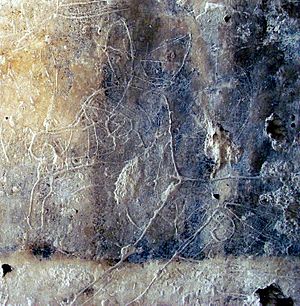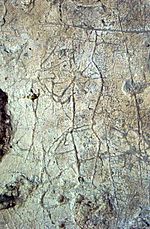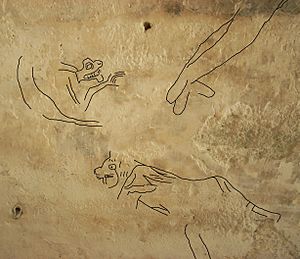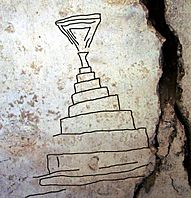Ancient Maya graffiti facts for kids

Ancient Maya graffiti are cool drawings and carvings made by the ancient Maya people. They are a type of folk art from the time before Europeans came to the Americas. These markings were scratched onto the plaster walls, floors, and benches inside many different buildings. You can find them in huge pyramid-temples, homes, and storage rooms.
Scientists have found graffiti at over 50 Maya sites, especially in places like the Petén Basin and southern Campeche, and the Chenes region of northwestern Yucatán. At Tikal, where lots of graffiti have been found, the drawings show temples, people, gods, animals, flags, special chairs carried by people, and thrones. Often, the graffiti were drawn without much planning, with drawings overlapping each other. Some look like they were made by people who weren't trained artists, while others show skill similar to the famous Classic-period (around 250–950 AD) Maya art.
It's usually hard to know exactly when Maya graffiti were made. Many are thought to be from the Late Classic (around 550–830 AD) and Terminal Classic (around 830–950 AD) periods. But some older graffiti have also been found. Some drawings might even have been made by people who moved into abandoned buildings after the main Maya civilization declined (around 950–1539 AD).
Maya graffiti are not like the planned decorations you see in buildings. Instead, they were added later to existing surfaces and don't seem to follow any special order. They are often scattered randomly on walls, floors, and benches. Sometimes, you find them in hidden spots, like dark corners or narrow hallways.
For a long time, people didn't pay much attention to Maya graffiti. Early explorers thought they were just odd drawings that weren't very important to understanding ancient Maya culture. In the late 1800s, Teoberto Maler was the first person to write down what he saw. Later, a few scholars in the 1900s also recorded more examples. By the end of the 20th century, graffiti had been found at places like San Clemente, Chichen Itza, Hochob, Holmul, Nakum, Santa Rosa Xtampak, Tikal, and Uaxactún.
Contents
Where is Ancient Maya Graffiti Found?
Graffiti has been found at Maya sites all across the Maya lands. In the Río Bec region of Campeche, in the southern Yucatán Peninsula, many buildings are still standing. This has helped preserve a lot of graffiti. Río Bec graffiti can be found in all types of stone homes, from simple one-room buildings to large palaces with many rooms. A study in the early 2000s found 464 graffiti in just 15 buildings in the Río Bec area!
What Do Maya Graffiti Show?
Ancient Maya graffiti show many different parts of ancient Maya life. They range from everyday scenes to important ceremonies. Today, these drawings are seen as a key way to learn about ancient Maya society. The subjects seem to be things the artists saw around them.
Many Maya graffiti are geometric shapes, abstract designs, or just scribbles. But among the drawings that show something clear, there's a huge variety. You can see full human figures, human-like creatures, human heads, buildings, gods, animals (like birds, insects, and snakes), ballcourts, and even hieroglyphs. Usually, each drawing is separate from others nearby. But sometimes, they form a bigger scene. A great example is at Tikal Temple II, where a scene of human sacrifice is shown. Some drawings at Tikal show groups of people in parades, and some group scenes are known from Río Bec. The most common things drawn are human figures and heads. At Río Bec, there aren't many war scenes, but there are drawings of human sacrifice.
At Río Bec, some complex drawings of ceremonies can be as long as 2.5 meters (about 8 feet). Many Río Bec graffiti are about the important people who lived there. But other graffiti, likely added by people who moved into the buildings after they were left empty, show new subjects like mythical creatures and female figures.
The quality of graffiti varies a lot. Some are simple drawings that look like they were made by children or are like cartoons. Others are very well-made drawings of people and animals, just as good as formal Classic Maya art. Most examples are somewhere in the middle. The subjects in graffiti usually match the kinds of things seen in other Classic period Maya art.
Who Made Ancient Maya Graffiti?
At first, people thought Maya graffiti were just messy scribbles made by people who lived in the ruins after the Classic period. But later, researchers like George F. Andrews thought graffiti was folk art made by the Classic Maya elite (important people) in their own homes and workplaces.
Interestingly, three pairs of graffiti found at both Río Bec and Holmul (sites over 130 km or 80 miles apart) are so similar in quality, technique, and tiny details that they were almost certainly made by the same untrained artist from the Late Classic period. These three designs are: a person sitting in a special covered chair carried by two people, a complex geometric symbol, and a person sitting and playing a wind instrument.
Early studies suggest that most ancient Maya graffiti were made by members of the Late Classic elite class. They drew these in their own homes and workplaces. Most of the people who made graffiti were not trained artists. The fact that most Maya graffiti are found in certain areas suggests that this practice became accepted among the Maya aristocracy. It seems to have spread between sites through these important families. At Río Bec, there's so much graffiti of different qualities that it's possible all the people living there, both adults and children, made drawings while the buildings were still in use.
Some people argued that graffiti at Classic period sites were made much later, in the Postclassic period. This idea was based on the fact that most graffiti don't look as good as formal Classic Maya art. These theories suggested that the graffiti were made by people who moved into the ruins and wanted to disrespect them. However, while some Río Bec graffiti was made during the time people lived there, other drawings do seem to have been added by later visitors after the buildings were abandoned.
How Was Ancient Maya Graffiti Made?
Maya graffiti were scratched onto surfaces using a sharp tool. The plaster walls at Maya sites are very hard, so making graffiti was difficult. Simple lines and curves were easier to make, but complex curves and delicate lines were tough. Because of the hard surface, mistakes couldn't be erased; new lines could only be added. Still, there are many very well-made drawings.
Why Did They Make Ancient Maya Graffiti?
The reason ancient Maya people made graffiti is still debated. Some think it was to disrespect buildings, while others believe they were instructional drawings, personal notes, or even part of magic. Most graffiti that show a clear subject seem to be related to the activities of important people. Graffiti of patolli game boards (an ancient Maya game) are almost always found on flat surfaces, which means they were likely used to play the game. Some researchers have even suggested that many graffiti at Tikal might have been made by artists in a trance state.
How Old is Ancient Maya Graffiti?
It's hard to know the exact age of ancient Maya graffiti. They could have been added at any time after a building was finished. However, some graffiti have been found in "sealed contexts." This means they were drawn on older buildings that were later completely covered by new construction. At Tikal, this has helped scientists date some graffiti to the Preclassic (around 2000 BC – 250 AD) and Early to mid-Classic periods (around 250 – 600 AD). Most graffiti at Tikal are found in buildings from the Late to Terminal Classic periods. Some examples at Río Bec and Uaxactún might even be older than the Late Classic.
There's a discussion about whether graffiti found in Late Classic buildings were made by the people living there at that time, or if they were added later in the Postclassic period. In the Central Acropolis of Tikal, benches were put in two buildings between 650 and 750 AD. These benches partly or fully covered existing graffiti. This tells us the graffiti must have been made no later than the early 700s. The style of other graffiti not covered by the benches suggests they were made around the same time. Similarly, at Río Bec, some graffiti were found covered by later building changes. At Uaxactún, some scratched graffiti were also painted red. The person who found them thought this meant the graffiti were made by the original residents, not by later visitors. At Tz'ibatnah, in northeastern Petén, a Late Classic building was also covered by later construction. This building had many graffiti linked to the important people who lived at the site.
For most graffiti, where they aren't covered by later building changes, it's not possible to know their exact date for sure. However, there is no solid proof that Postclassic graffiti were added to Late Classic buildings.
See Also






